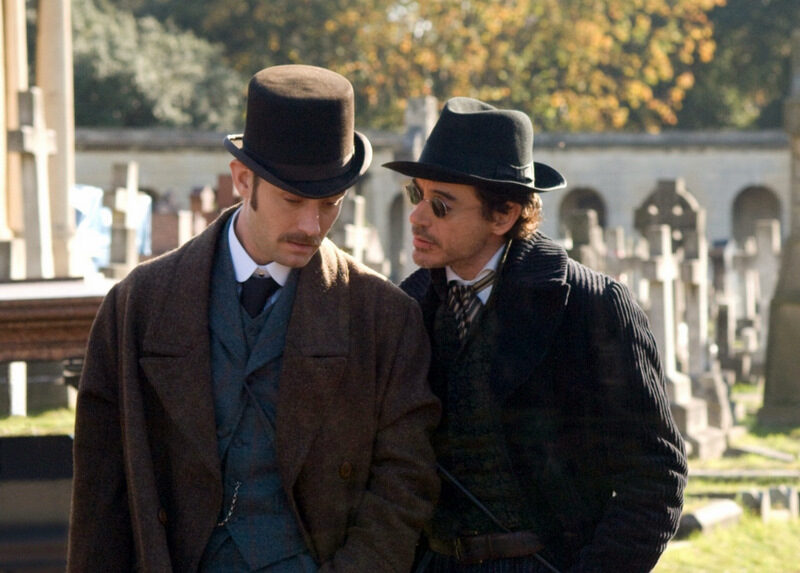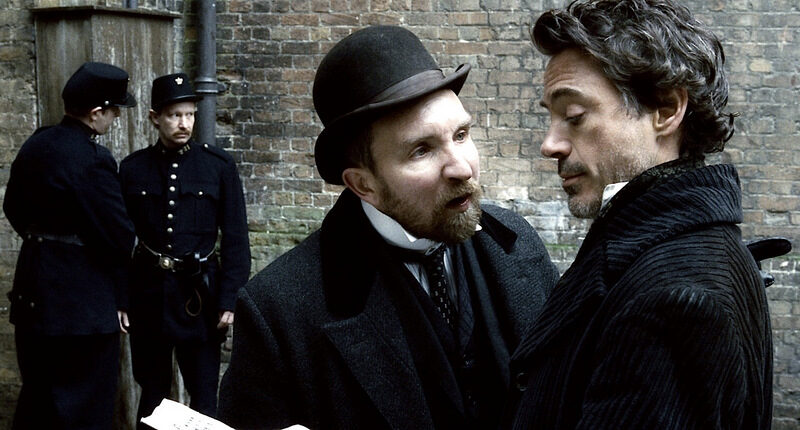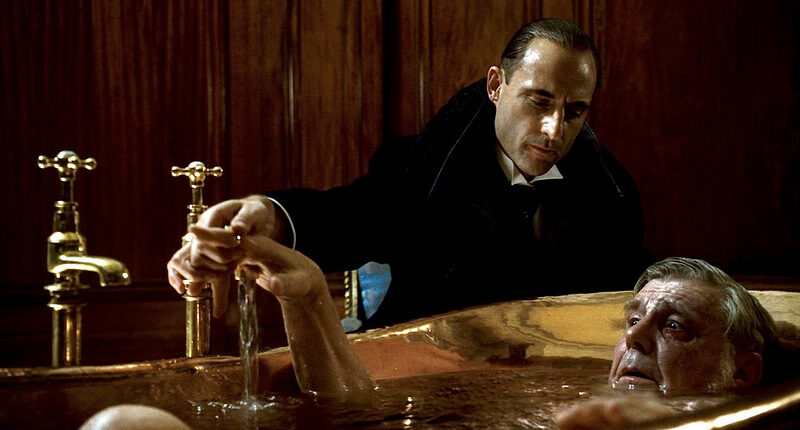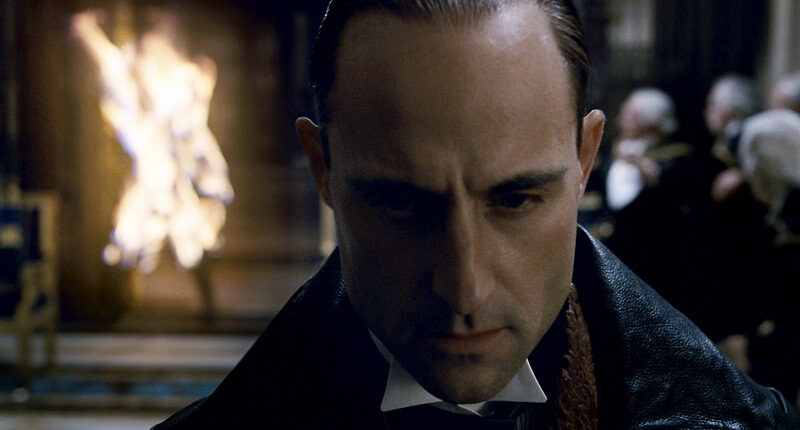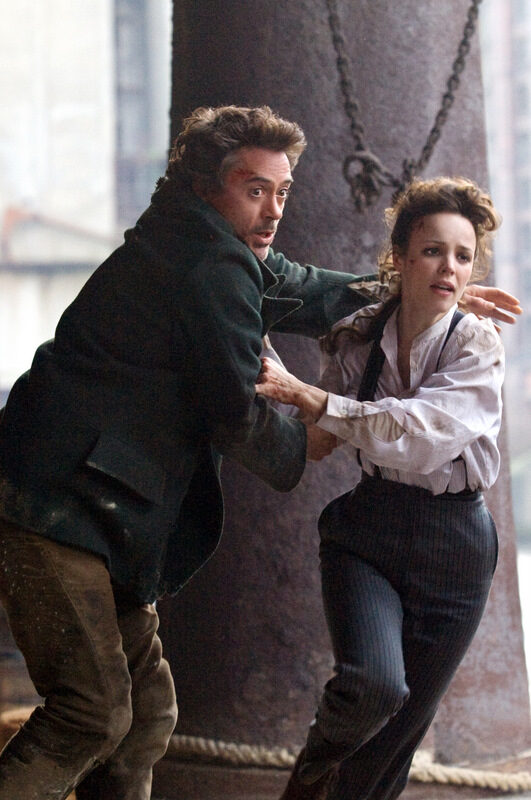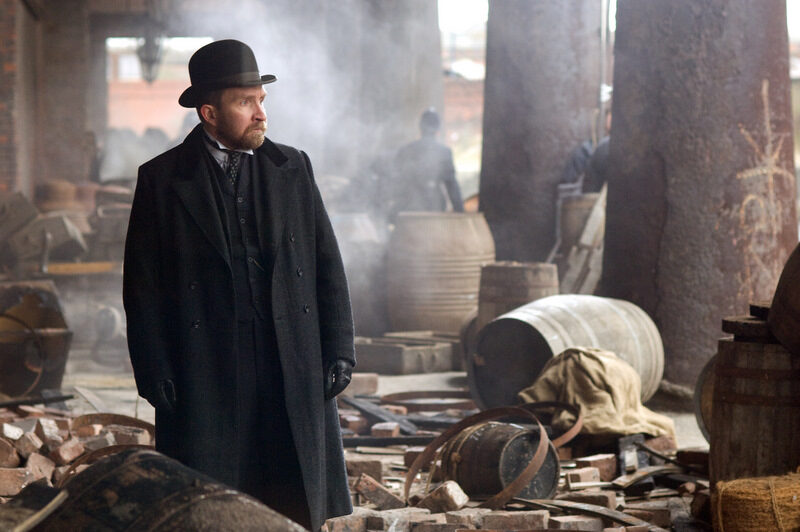Sherlock Holmes Costume Guide Part 2: Tweed Suits and Ulsters | Clothes on Film
Second and final part in our sartorial analysis of Sherlock Holmes (2009), complete with insight from costume designer Jenny Beavan.
Excited by the mystery of Lord Blackwood’s apparent ‘resurrection’, Holmes actually makes a genuine effort to appear neat for once (the restaurant date does not count as he was prompted).
Holmes strolls into the cemetery beside Watson and Constable Clark wearing a black single breasted whale cord frock coat, high fastening with stand collar waistcoat in green and gold flower pattern silk, striped silk scarf, light grey pinstripe trousers, white shirt with unbuttoned cuffs, wideawake hat (too wide a brim for a trilby, too soft for a homburg) and round-framed sunglasses. These are unquestionably a modern version; gold-rimmed ‘teashades’, which are generally similar in design to Victorian ‘cinder glasses’ as used for protection during early rail travel.
Holmes radiates bohemian. For the first time we get the impression that maybe he creates his persona more than happens upon it. That he is as dedicated to anti-fashion as Watson is to fashion. Jenny Beavan believes Holmes is an “old romantic” at heart; indeed he dresses similar to the romantic poets of the 1860s. Important to note, however, that his clothes despite their apparent wackiness are largely period accurate.
Watson, distinctive in a brown coachman’s hat, wears sturdier fabrics than Holmes, his double breasted overcoat likely made from heavy wool cloth, its ample cut more evolved than the waistless paletot first seen around 1840. The pattern is possibly based on a ‘paddock coat’ which was considered sporting attire and informal by lacking a belt and waist seam. Later this would develop into the camel hair ‘polo coat’, a consistently popular item throughout the 1920/30s.
Analysing the crime scene with Lestrade, Holmes discovers that Blackwood’s coffin is filled with the body of another man, a midget named Reordan. Here we see why Holmes often wears a belt and braces; the belt is necessary to carry his tool kit. With the revelation that Blackwood is not dead after all, Watson’s reputation as attending physician at his execution evidently ‘hangs’ in jeopardy.
As they walk through a hectic street market, Watson proffers that perhaps a supernatural element is present in the case. Amazingly Holmes appears to agree with him. It soon becomes apparent that this part of town offers more than a decent portion of beer battered fish and chips, as a gypsy palm reader (Bronagh Gallagher) warns Watson that Mary will “turn to fat” and be covered in warts (“Are they extensive?!” bellows Holmes).
Grasping that Holmes has clearly paid the woman to say these things, Watson marches into an adjacent jewellery store to buy Mary an engagement ring. This stunning decorative piece plus Mary’s pendant came courtesy of Sherlock Holmes’ producer Joel Silver. Beavan confirms, “It was then set and reset according to our needs. I liked it, we used it”.
Leaving Watson behind, Holmes attempts to break into Reordan’s lodgings with his utility ‘Bat Belt’. This is not where his real skills lay as it takes a swift kick from Watson’s Balmoral boot to get the job done properly.
Inside Reordan’s lodgings is where Holmes makes most of his deductions that fall into place during the final act. However it does not take long until they are disturbed. Two shady looking characters along with a polite but lethal giant named ‘Dredger’ (Robert Maillet) arrive, all done out in mismatched cloths and untrustworthy loud checks.
A brawl ensues with Holmes displaying his customary ‘Bartitsu’ mix of boxing, martial arts, fencing and, on this occasion, handily available electric power rod. Watson meanwhile scraps away like a bulldog, managing to lose his engagement ring in the process. Holmes chases Dredger as he flees to a nearby boat-building warehouse who then turns the tables by ‘Donkey Konging’ Holmes with a rolling barrel and escapes. Both Holmes and Watson are subsequently arrested after accidentally launching a half-completed ship into the River Thames.
Cooling off, both men sit in the open prison yard. Oddly, Watson seems to be dressed in a different jacket; the lapels are turned up and fastened with a tab collar. It looks to be a sporting garment, though Jenny Beavan maintains it is the same jacket as before (admittedly largely obscured beneath his overcoat).
Jude Law undertakes several costume changes during the movie; though many are mixed and matched from previously seen items. Watson rotates three suits, two Harris Tweed and a blue checked sporting tweed as seen here with five back seams and decorative buttons that was not a Harris.
Reaching a low point in their staunch camaraderie, Watson accuses Holmes of trying to sabotage his relationship with Mary – which of course he is. Holmes claims that marriage is not for Watson, that he will “miss the thrill of the macabre”.
Appropriately enough at that point Mary arrives to bail Watson out. She wears a cool grey dress with pleated bodice, nipped-in waist, high fastening embossed buttons and shoulder cape with hood. Beavan explains that this relatively plain Ulster over-garment “just seemed the right thing for that particular moment in the film”. Black and grey were not only for funerals and evenings during the Victorian era; they were perfectly acceptable as daywear for both men and women.
It is the perpetually flustered figure of Inspector Lestrade who comes to fetch Holmes. As he paces out of the yard we are granted full view of his ‘Chesterfield’ overcoat. First appearing mid-nineteenth century, the Chesterfield is identifiable by a slightly fitted waist, either single or as in the case of Lestrade, formal double breasted. By 1900 a fly front and velvet collar were added. Watch too for a revealing shot of the coachman’s Ulster; longer than Lestrade’s Chesterfield but constructed of a lighter material.
Following a pointlessly blindfolded coach trip, Holmes discovers that his bail was secured by the Temple of the Four Orders, a Freemason-esque secret organisation spanning centuries of occult worship. They are a gloomy bunch in drab, rather loose fitting frock coats. Their leader is Sir Thomas (James Fox) who Holmes straightaway reasons must also be Lord Blackwood’s father. The Order wants Holmes to catch supposedly resurrected Blackwood, something he agrees to do but only on his own terms, i.e. without their involvement.
Choosing Irene Adler as his first port of call, Holmes attempts to break into her hotel room with his tool kit. She helps him out by opening the door instead (anyone spotting a theme here?). As he questions her role in events, she changes into a stunning mauve and gold Kimono dress. Worn off the shoulders, it is made from damask silk with a slight floral weave that separated when dyed. In addition to denoting Adler as a seasoned traveller the dress helps elevate her ‘softer’ side.
However she cleverly turns such an assertion on its head. Having drugged Holmes unconscious just minutes after he walked into the room; Adler is a femme fatale, molding then subverting the male construction of femininity. She places susceptible men off their guard by playing to their expectations. Jenny Beavan agrees, “She’s not a shrinking violet that one!”
After much foreboding we finally get to see Mark Strong return as Lord Blackwood back from the grave as it were. Dispatching his father Sir Thomas and taking the Four Orders ring, Blackwood glares at us from the shadows, the upturned lapels of his leather coat bestowing a Dracula-like presence. Even Beavan admits Blackwood is “a bit of a stage baddie”. The black leather coat was actually from the 1970s period, a trenchcoat specifically, that Beavan and her team “Victorianised”.
Holmes is next seen awake in Adler’s hotel room, now alone handcuffed to the bed and naked but for a strategically placed cushion. Thanks to an insulted chamber maid, he is rescued by Constable Clark and taken to investigate Sir Thomas’ murder. Holmes’ journey with Clarkey involves one of the funniest dialogue exchanges in the film, revealing there is more to the steady beat copper’s personality than just stern facial expressions and a no-nonsense manner.
Proceeding Holmes’ dissection of the crime scene, where he sneakily procures Sir Thomas’ Four Orders notebook from a secret chamber, we rejoin Blackwood as he takes command of the group and announces his plans for world domination, it has to be said now looking more like The Count than ever.
Back in Baker Street and Watson returns to the story. He watches trying not to appear interested as Holmes examines the dead body of a thug from Reordan’s lodgings. Both men (not the corpse) wear striped shirts. Watson in white with thin blue and brown stripes, Holmes a less customary light brown and as comfortably slack as usual.
Watson’s waistcoat on his brown herringbone Harris Tweed suit is worthy of note; it is particularly high buttoned hiding most of his shirt front with no revers, a fashionable touch in late 19th century. Holmes sports block striped braces with brown trousers and a thick leather belt. The belt acts as a makeshift holster for the revolver he casually leaves behind after making a break in the case. Watson reluctantly takes the carrot and follows after him.
They travel to their next destination: a slaughterhouse at Nine Elms via a laborious trip up river, for Watson anyway, in the smoggy dead of night. Having removed his stiff collar and jacket, Watson is a tad more comfortable for stoking coal. Though notice how he reapplies his jacket upon leaving the boat? Yes, it is chilly by the Thames, but more significantly Watson is a true Victorian gentleman and a Victorian gentleman did not go anywhere without a jacket.
Disguised as a deckhand, Holmes has already prepared for the elements in a dark grey reefer or pea coat, wool Fisherman’s cap and brown moleskin trousers. The pipe he smokes is a Billiard, not the curved stem Calabash usually favoured for screen interpretations of the character. It has an entirely straight stem and mouthpiece.
Inside the slaughterhouse Watson and Holmes are surprised by Blackwood who discovered Adler secretly tailing them and chained her to a meat hook. He flicks a switch to activate the band saw and makes good his escape. Away from the pretty frocks, here Adler wears part of a man’s pinstripe suit including slim trousers, braces and half boots. Just like Holmes she is in disguise, although the intention behind this idea remains undetermined.
“It is no longer clear to me why Irene is suddenly dressed as a man” Beavan states. “We did have a scene where she changed three times before ending up in men’s clothes, but the producers decided they wanted a different scene at that point”. As based on Conan Doyle’s original creation, Irene Adler is a cross-dresser anyway (for social reasons not sexual transvestism). Likewise with several characters in his books, “They are all into cross-dressing if needed” she adds.
During Adler’s rescue, eagle eyed viewers may have spotted Watson wearing a belt partially covered by his waistcoat. We already know he chooses braces so it’s likely this is intended as his gun belt. “Watson is a military man; Holmes forgets his gun on purpose” confirms Beavan. “He knows how to get Watson to come and protect him!”. Ironic that with all the discussion surrounding Holmes’ transformation from Deerstalker wearing gent to bare-knuckle boxer detective, it is probably this new Watson who will seem least familiar to moviegoers.
Blackwood sails away from the slaughterhouse in a tall top hat (the silhouette of a conjurer) seconds before Watson inadvertently triggers a hidden trip wire. A tremendous explosion engulfs the building. Adler manages to escape in the confusion. Constable Clark meanwhile grants semi-conscious Holmes a head start, warning him that Home Secretary Lord Coward (Hans Matheson) has issued a warrant for his arrest. Watson has survived the blast though is seriously injured.
Adler attempts to flee London in her ‘travelling costume’, a sculptured purple satin dress with lace sleeves, pink bustle detail and hat. However she is intercepted by her employer at the train station. Still in shadow; top hat, cape coat and leather gloves his only visual distinction, the well-spoken man reminds Adler she still has a job to do. If she does not fulfil her task harm will come to Sherlock Holmes. Reluctantly she agrees to continue. This is something both Holmes and Adler have in common, their weakness for each other.
Holmes poses as a doctor in white coat and false beard to visit Watson in hospital. Waiting bedside, Mary Morstan soon rumbles his masquerade. She is appropriately dour in flowing grey dress with white lace collar, cuffs and neck bow. Mary is far less extravagant than Adler; someone who would no doubt ‘pick herself up’ with clothes. Perhaps surprisingly, Mary is compassionate to Holmes’ emotional pain. Inspired by her fortitude he determines more fervently than ever to solve the case.
Holed up at the Punch Bowl inn stripping down to his white shirt with impractically unbuttoned sleeves, brown trousers, block striped braces and puffing on that Billiard pipe, Holmes attempts to re-enact Blackwood’s initial ritual using the notebook he found in Sir Thomas’ chamber. He throws all sorts of ingredients into the mix before passing out in an intoxicated haze. When he wakes, Watson and Adler are watching over him.
Watson looks well considering. Mending but still pristine, he wears his grey three piece lounge suit. The jacket is buttoned ‘Richmond style’, i.e. only the top button is fastened and pulled open to expose his waistcoat. Those heavy Balmoral boots remain along with brown necktie and matching bowler. Adler’s purple satin dress seems ever more sumptuous; its skirt covering the legs of her chair. Her trilby style hat pulled down at a slight angle adds a dash of cheeky fun, as befits the character.
Holmes has changed into fresh trousers and a grimy grey undershirt. He explains that the experiment has revealed Blackwood’s next location as the Houses of Parliament. Yet before the trio can give pursuit, Inspector Lestrade and his constables arrive. Watson and Adler get away but Holmes waits behind to be arrested. He is taken to see Lord Coward, seemingly at Lestrade’s behest, as the inspector reveals his allegiance to the Four Orders by flashing a club lapel pin.
Shackled, Holmes is left alone with Lord Coward, who turns his back to load a pistol. On entering the room Holmes clocked Coward’s recently worn muddy boots standing in the doorway. They are distinctive footwear for the period allowing them to function specifically as a plot device.
These elastic-sided town boots would have been constructed from leather and Indian Rubber Cloth. They feature from around 1837. Dried mud in the soles provides Holmes with the sewer location. Before Lord Coward can open fire, he removes his shackles and leaps out of the window several stories from Parliament into the River Thames. Adler and Watson are waiting to collect him in a steamboat.
Adler is decked in tight tweed suit with a red silk back to her waistcoat (revealed later), her trousers tucked into calf length lace-front boots giving the appearance of plus-fours. Without such slender footwear this could be gentlemen’s cycling attire in the late 1800s. The assumption here is that Adler is in disguise again, though this outfit also has practical implications in costume terms. It is difficult to see how the upcoming all-action finale would play out in swathes of satin and a bustle.
Watson’s briefly seen leather gloves would be essential wear for all Victorian men in town and country; kid and chamois for the former, wool for the latter.
Their swift river trip reveals Lestrade as party to Holmes’ deception in exposing Lord Coward (explaining his removal of the shackles). On arrival in London’s newly built sewers, Holmes has changed back into his black single breasted frock coat, black waistcoat with brass buttons, Harvard stripe scarf, white high collar shirt, black trousers and big buckle belt.
Soon the trio encounter Blackwood’s cronies. Adler bounds in first opening fire with a revolver. Holmes and Watson battle individual comers hand-to-hand with varying degrees of finesse. At one point Holmes fights a man dressed in indigenous Chinese ‘boxer’ style tunic and cap. Evidently a hint to the ‘wushu’ moves the man is about to unleash; his actions, simplification or not, are predetermined by costume. We know this character is about to perform martial arts or why else would he be dressed like that? Presenting a cross-section of society is not enough in a major motion picture; secondary players, if they are seen to stand out have to stand out for a reason.
Instantly recognisable in that enigmatic long leather coat, Blackwood arrives to address Parliament with a slightly hesitant speech about Britain taking over the world, before then attempting to gas his unimpressed audience to death.
However the convoluted con he has so painstakingly put into place fails thanks to Holmes and his determined compatriots. Realising the game is up, Blackwood makes a particularly non-enigmatic escape through the sewers. Spying Adler with the gas canisters he was intending to unleash on Parliament, Blackwood gives chase onto an as yet unfinished London Bridge. They run very fast.
Holmes gets there first, although he scarcely has a moment with Adler before Blackwood rushes in nearly knocking her into the Thames. Blackwood cringes as Holmes reveals his so-called magic as conjuring tricks, his resurrection nothing more than a stunt relying on implied fear, some friends in low places and a liberal use of honey. He lunges at Holmes in a final frenzy before tumbling off the bridge and hanging himself by the neck – for real this time.
After being rescued by Holmes, Adler divulges her employer’s name as (wait for it) ‘Professor Moriarty’; as smart as Holmes and “infinitely more devious”. They bid a hurried goodbye and Holmes departs, recovering the Maharaja’s ‘lost’ yellow diamond from Adler’s neck as he does so.
There are several prominent shots of Adler’s plush leather boots during this scene. They are based on a biker design and made by Pompeii in Italy. The principal female costumes for the film were tailored by Jane Law at Jane Law Ltd for Cosprop with Stephen Miles running a workroom for the stunt costumes; Cosprop co-ordinated the whole operation through Beavan.
For the film’s epilogue, that five minute breather to explain holes in the plot before the credits roll, we return to Baker Street. It is moving day for Watson wearing a full length, double breasted houndstooth overcoat atop his brown Harris Tweed lounge suit, white stiff collar, gold stud and brown necktie with high crown bowler – and he is visibly sweating under the weight.
Mary accompanies him in med-purple satin dress with swirls, bustle and pleated hem; contrasting silk wrap coat with fur trim, wrap-over and swept open at the front, topped off by velvet bonnet and fur muff.
They discover Holmes in his quarters re-enacting Blackwood’s original ‘hanging’. He is attired in familiar green patterned waistcoat, black trousers and white open neck shirt. After establishing how he will clear Watson’s name, Holmes retires to the comfort of his threadbare antique dressing gown. The costumes in Sherlock Holmes are specific to imply time, location and tone, but most important of all character.
This was paramount for Jenny Beavan from day one, “They are character driven” she asserts. “Accurate in a way but using garments from former times. If you have done your research and are in tune with the director often things happen that are just ‘right’ but not necessarily designed in a conscious manner”.
In a latent plot twist the true intention behind Moriarty’s involvement in the mystery is revealed. Much to Holmes’ obvious delight and Watson’s obvious concern for the inevitable, a new game is afoot. Or as Holmes excitedly announces as he peers out onto a city with endless secrets, “Case reopened”.
The final shot of the film is of Holmes placing a purple felt trilby on his head, cockeyed as usual. It is a wink to the audience. If you thought the world’s greatest detective looked radical before, just wait until you see him next time. This Sherlock Holmes has no intention of a quiet reunion.
With thanks to Jenny Beavan.
© 2010 – 2012, Chris Laverty.
Related Posts:
